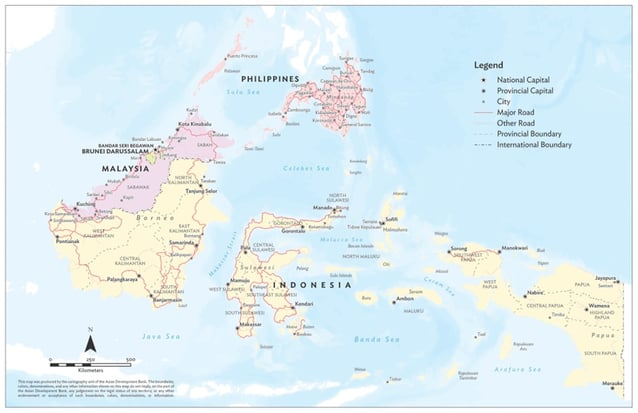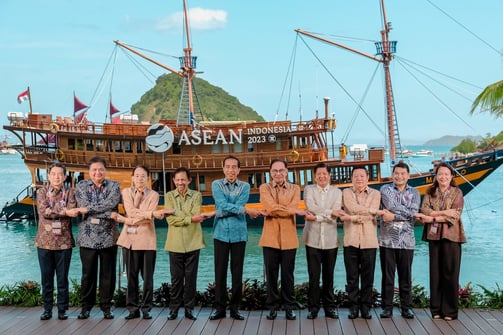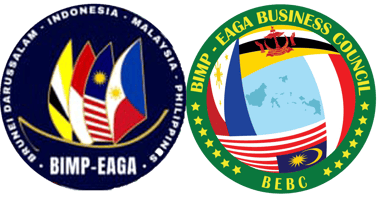What is BIMP EAGA


The Brunei Darussalam–Indonesia–Malaysia–Philippines East ASEAN Growth Area, or BIMP-EAGA, is a cooperation initiative established in 1994 to spur development in remote and less developed areas in the four participating Southeast Asian countries.
The subregion covers the entire sultanate of Brunei Darussalam; the provinces of Kalimantan, Sulawesi, Maluku, and West Papua of Indonesia; the states of Sabah and Sarawak and the federal territory of Labuan in Malaysia; and the island of Mindanao and the province of Palawan in the Philippines. These areas are geographically far from the national capitals, yet strategically close to each other. These states and provinces account for over 60% of the land area of the BIMP-EAGA countries; yet they make up about 18.8% of the total population and 18.4% of the labor force.
Map of Brunei Darussalam–Indonesia–Malaysia–Philippines East ASEAN Growth Area. Source: Asian Development Bank (ADB).
Through BIMP-EAGA, the four countries want to generate balanced and inclusive growth as well as contribute to regional economic integration in the ASEAN Economic Community. They want to boost trade, tourism, and investments by easing the movement of people, goods, and services across borders; making the best use of common infrastructure and natural resources; and taking the fullest advantage of economic complementation.
Thanks to strong ownership and commitment, as demonstrated by the financial, human and technical resources put in by the member governments, BIMP-EAGA has grown over the last 29 years.
BIMP-EAGA’s economy in 2022 grew by 7.7%. The gross domestic product (GDP) at current prices was valued at $392.1 billion, accounting for 18.9% of the combined GDP of the four countries. Total trade in goods last year increased by 34.7% to $198.7 billion, comprising exports valued at $141.8 billion and imports amounting to $56.9 billion. Foreign direct investment went up by 46.7% to $19.9 billion and domestic investment by 19.3% to $ 8.7 billion. Tourism is on track to full recovery with arrivals increasing by 137.3% to 114.8 million in 2022 from 48.4 million in 2021.
As of October 2023, the number of priority infrastructure projects (PIPs) of BIMP-EAGA has increased by threefold to 129, amounting to $38.87 billion, from only 57 projects in 2017 when the BIMP-EAGA Vision 2025 was adopted. Of the total, 48 projects (37%) have been completed, while 81 projects are in various stages of implementation. Financing for many PIPs has been secured. These projects include roads, bridges, and railways; seaports and airports; cross-border facilities and inland transport services; ICT infrastructure; power interconnections; and urban development infrastructure and services. The PIPs provide farmers and fisherfolk improved access to markets, deliver reliable energy to rural communities, catalyze trade in border areas, and boost tourist arrivals.
BIMP EAGA Vision 2025?
Since its creation in 1994, BIMP-EAGA has been a highly effective mechanism for member countries to accelerate social and economic development in remote and less developed areas.
Now, as new trends and challenges emerge both regionally and globally, the organization has drawn up a blueprint for keeping itself relevant, going forward. It aspires to become resilient, inclusive, sustainable, and economically competitive.
BIMP-EAGA’s Vision 2025, prepared with support from the Asian Development Bank, provides a way forward for members to continue narrowing development gaps, for sustainably managing natural resources, and for promoting stronger connectivity. It focuses on three main outcomes:
Developing a competitive and “green” manufacturing sector that can add value to production.
Creating sustainable, competitive and climate-resilient agriculture and fishing industries.
Adopting a multi-country approach to tourism that benefits less developed areas.
Its objectives have clear targets and indicators (2015, baseline):
EAGA represents 20% of the BIMP economy.
Intra-EAGA trade increased to 10% of total trade.
EAGA exports increased to $240 billion.
Foreign direct investments increased to $66 billion.
Foreign and domestic tourist arrivals increased to 124 million.
Agriculture and fisheries output increased by 10%.
200 small and medium-sized enterprises adopting green technologies.


BIMP EAGA Strategic pillars and sector strategies
Five long-term strategic thrusts guide the development path to 2025:
Enhancing connectivity within and outside BIMP-EAGA,
Establishing the subregion as a food basket in ASEAN and the rest of Asia,
Promoting BIMP-EAGA as a premier tourism destination,
Ensuring the sustainable management of natural resources, and
Promoting people-to-people connectivity through socio-cultural understanding and increasing mobility.
At the sectoral level, Vision 2025 provides the following strategies:
Transport. Improve intra-EAGA air routes, airport facilities, ferry services roads, and other related infrastructure, so that there are seamless multimodal connections.
Trade and Investment Facilitation. Further streamline rules and procedures for cross-border trade and do more to integrate small-and-medium-sized enterprises into supply and value chains.
Energy. Continue interconnection and rural electrification projects and scale up renewable energy activities and efficiency and conservation measures.
ICT. Strengthen information and communication technology systems, including improving infrastructure, human resources, and the adoption of innovations.
Agriculture and Fisheries. Adopt more climate-resilient production practices and develop subregional supply and value chains for priority commodities.
Tourism. Improve connectivity to tourist destinations, develop and support green ecotourism sites, and provide sustainable tourism-based livelihoods.
Environment. Mainstream sustainable management approaches in ecosystems by promoting ecotourism, climate-resilient farming and fishing practices, and clean and green production technology.
Socio-cultural and Education. Enhance people-to-people connectivity and knowledge exchange and develop highly competent human resources through strong partnerships among education and training institutions.




Striving for growth
While no fundamental changes are planned to its structure, BIMP-EAGA will seek to strengthen project operations through more focused and disciplined planning and implementation. It will regularly review its institutional mechanisms to ensure they remain responsive to the needs of members. Results-based monitoring and evaluation of projects will be carried out to assess the overall development effectiveness of the organization. Stepped-up communications activities will be conducted to raise public awareness on BIMP-EAGA, and it will continue working with ASEAN and other subregional initiatives to cooperate in activities of mutual interest. BIMP-EAGA will also continue to seek resources from the private sector to drive growth, with governments playing the role of facilitator. Vision 2025 is a “living” document that members will periodically review and enhance as necessary during the implementation period (2017–2025). It succeeds BIMP-EAGA’s Implementation Blueprint (2012–2016) and Roadmap (2006–2010)
Sabah Blue Economy Business Community
Fostering economic growth in BIMP-EAGA region.
Connect
Support
+6016-883-7168
© 2024. All rights reserved.
